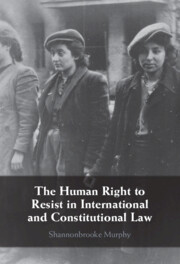Book contents
- The Human Right to Resist in International and Constitutional Law
- The Human Right to Resist in International and Constitutional Law
- Copyright page
- Dedication
- Contents
- Foreword
- Acknowledgments
- Table of Cases
- Table of Treaties and Legislation
- Table of Other Authorities
- 1 Introduction
- Part I The Concept
- 2 Advancing a Legal Definition of the Right
- 3 Clarifying the Nature and Legal Function of the Right
- 4 Identifying the Elements and Legal Content of the Right
- Part II The Law
- Bibliography
- Index
4 - Identifying the Elements and Legal Content of the Right
from Part I - The Concept
Published online by Cambridge University Press: 20 February 2025
- The Human Right to Resist in International and Constitutional Law
- The Human Right to Resist in International and Constitutional Law
- Copyright page
- Dedication
- Contents
- Foreword
- Acknowledgments
- Table of Cases
- Table of Treaties and Legislation
- Table of Other Authorities
- 1 Introduction
- Part I The Concept
- 2 Advancing a Legal Definition of the Right
- 3 Clarifying the Nature and Legal Function of the Right
- 4 Identifying the Elements and Legal Content of the Right
- Part II The Law
- Bibliography
- Index
Summary
This chapter identifies and examines the elements determining the legal content of any given theory of, or positive law provision for, the human right to resist. It reviews the primary triggers or conditions for activation, indicating the ‘right to resist what’, including ‘tyranny’, ‘oppression’, and ‘other violations’. It reviews the secondary triggers or conditions for activation, indicating the ‘right to resist when’, in particular the necessity condition. It also reviews both aspects of the personal scope, being the rights-holders, indicating ‘who may resist’, and also the duty-bearers, indicating ‘whose corresponding duty’. It identifies a four-fold typology of legitimate ‘object and purpose’, or ‘right to resist why’, being for human rights enforcement, for self-defence, for self-determination, and for ‘peace’ or human security. The final element examined is the material scope of application, or ‘right to resist how’, identifying three competing approaches to permissible means, and affirming proportionality limitations and other applicable limitations in international human rights law and international criminal law, as well as grounds for discretionary non-exercise. This general analytical template for identification and comparison of elements and therefore content is then applied to the evidence of legal sources of the right considered in Chapters 5–7.
Keywords
- Type
- Chapter
- Information
- Publisher: Cambridge University PressPrint publication year: 2025

